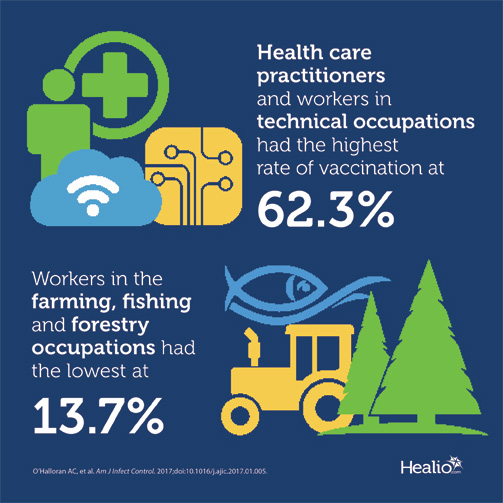Influenza vaccine coverage varies by occupation
A telephone survey across 21 states found that influenza vaccine coverage varied significantly across a wide array of industries in the U.S., with workers in the construction, farming and food service industries ranking among the lowest levels of coverage.
“Knowledge of influenza vaccination coverage among health care personnel and other occupational groups can help guide prevention efforts and be useful during an outbreak response,” Alissa C. O’Halloran, MSPH, of the immunization services division at the National Center for Immunization and Respiratory Diseases, CDC, and colleagues wrote. “Additionally, influenza vaccination coverage rates can assist in influenza pandemic planning.”
The researchers analyzed data from the 2013 Behavioral Risk Factor Surveillance System, which included an industry-occupation module identifying 22 broad groups of occupations. The survey was coordinated between the CDC and the health departments of all participating states.
Higher levels of education, having health insurance and a usual place for health care, as well as having at least one physician visit in the previous year were all independently associated with vaccination, O’Halloran and colleagues wrote.
Health care practitioners and workers in technical occupations had the highest rate of vaccination, at 62.3%, whereas workers in the farming, fishing and forestry occupations had the lowest, at 13.7%.
Physicians and surgeons had the highest rates of vaccination coverage among all health care personnel (75.8%). Inpatient health care personnel (65.5%) had higher vaccination rates than outpatient personnel and workers in physicians’ offices (52.8%), other clinical settings (46.7%) and long-term care facilities (41.6%).
“Influenza vaccination coverage varied across industries in our study,” O’Halloran said in a press release accompanying the study. “Increasing influenza vaccination can reduce the spread of influenza in the workplace. This is especially important for health care personnel, public health responders and people in other occupations who are more likely to be exposed to influenza and possibly spread it to patients or people who are at high risk of serious flu complications.” – by Andy Polhamus
Disclosure: The researchers report no relevant financial disclosures.


